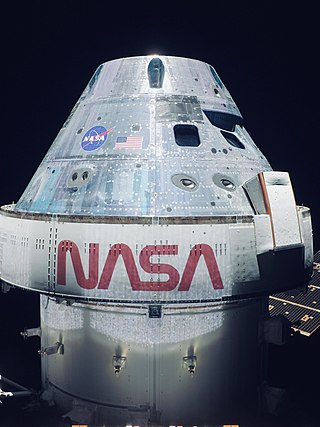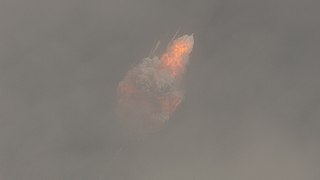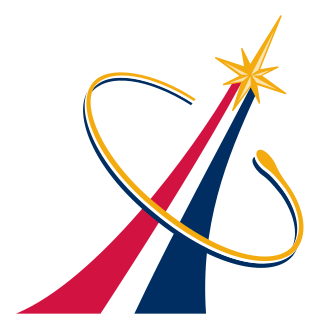
STS-51-F was the 19th flight of NASA's Space Shuttle program and the eighth flight of Space Shuttle Challenger. It launched from Kennedy Space Center, Florida, on July 29, 1985, and landed eight days later on August 6, 1985.

AS-201, flown February 26, 1966, was the first uncrewed test flight of an entire production Block I Apollo command and service module and the Saturn IB launch vehicle. The spacecraft consisted of the second Block I command module and the first Block I service module. The suborbital flight was a partially successful demonstration of the service propulsion system and the reaction control systems of both modules, and successfully demonstrated the capability of the command module's heat shield to survive re-entry from low Earth orbit.

STS-41-D was the 12th flight of NASA's Space Shuttle program, and the first mission of Space Shuttle Discovery. It was launched from Kennedy Space Center, Florida, on August 30, 1984, and landed at Edwards Air Force Base, California, on September 5, 1984. Three commercial communications satellites were deployed into orbit during the six-day mission, and a number of scientific experiments were conducted, including a prototype extendable solar array that would eventually form the basis of the main solar arrays on the International Space Station (ISS).

The Apollo spacecraft was composed of three parts designed to accomplish the American Apollo program's goal of landing astronauts on the Moon by the end of the 1960s and returning them safely to Earth. The expendable (single-use) spacecraft consisted of a combined command and service module (CSM) and an Apollo Lunar Module (LM). Two additional components complemented the spacecraft stack for space vehicle assembly: a spacecraft–LM adapter (SLA) designed to shield the LM from the aerodynamic stress of launch and to connect the CSM to the Saturn launch vehicle and a launch escape system (LES) to carry the crew in the command module safely away from the launch vehicle in the event of a launch emergency.

An escape pod, escape capsule, life capsule, or lifepod is a capsule or craft, usually only big enough for one person, used to escape from a vessel in an emergency. An escape ship is a larger, more complete craft also used for the same purpose. Escape pods are ubiquitous in science fiction but are only used in a few real vehicles.

A-002 was the third abort test of the Apollo spacecraft.

A-003 was the fourth abort test of the Apollo spacecraft. This particular flight is notable because during the abort test flight, an actual abort situation occurred, and further proved the Apollo launch escape system (LES). The CM was successfully pulled away from the malfunctioning Little Joe booster and it landed safely under parachutes.
Apollo abort modes were procedures by which the nominal launch of an Apollo spacecraft, either the Saturn IB or Saturn V rocket, could be terminated. The abort of the flight allowed for the rescue of the crew if the rocket failed catastrophically. Depending on how far the flight had progressed, different procedure or modes would be used. In the history of the Apollo Program, none of the abort modes were ever used on any of the fifteen crewed Apollo spacecraft flights.

A launch escape system (LES) or launch abort system (LAS) is a crew-safety system connected to a space capsule. It is used in the event of a critical emergency to quickly separate the capsule from its launch vehicle in case of an emergency requiring the abort of the launch, such as an impending explosion. The LES is typically controlled by a combination of automatic rocket failure detection, and a manual activation for the crew commander's use. The LES may be used while the launch vehicle is on the launch pad, or during its ascent. Such systems are usually of three types:

Space Shuttle abort modes were procedures by which the nominal launch of the NASA Space Shuttle could be terminated. A pad abort occurred after ignition of the shuttle's main engines but prior to liftoff. An abort during ascent that would result in the orbiter returning to a runway or to an orbit lower than planned was called an "intact abort", while an abort in which the orbiter would be unable to reach a runway, or any abort involving the failure of more than one main engine, was called a "contingency abort". Crew bailout was still possible in some situations in which the orbiter could not land on a runway.

The HL-20 Personnel Launch System was a NASA spaceplane concept for crewed orbital missions studied by NASA's Langley Research Center around 1990. It was envisaged as a lifting body re-entry vehicle similar to the Soviet BOR-4 spaceplane design. Its stated goals were to achieve low operational costs, improved flight safety, and a possibility of landing on conventional runways. No flight hardware was built.

The Orion Multi-Purpose Crew Vehicle is equipped with a launch escape system. Orion has several abort modes. Some of these may not use the LAS itself, but would use the second stage of the SLS, or even the Orion vehicle's own propulsion system instead.
A terminal countdown demonstration test (TCDT) is a simulation of the final hours of a launch countdown and serves as a practice exercise in which both the launch team and flight crew rehearse launch day timelines and procedures. In the specific case of a TCDT for the Space Shuttle, the test culminated in a simulated ignition and RSLS Abort. Following the simulated abort, the flight crew was briefed on emergency egress procedures and use of the fixed service structure slidewire system. On some earlier shuttle missions, and Apollo missions, the test would conclude with the flight crew evacuating the launch pad by use of these emergency systems, but this is no longer part of the test.

Orion is a partially reusable crewed spacecraft used in NASA's Artemis program. The spacecraft consists of a Crew Module (CM) space capsule designed by Lockheed Martin and the European Service Module (ESM) manufactured by Airbus Defence and Space. Capable of supporting a crew of four beyond low Earth orbit, Orion can last up to 21 days undocked and up to six months docked. It is equipped with solar panels, an automated docking system, and glass cockpit interfaces modeled after those used in the Boeing 787 Dreamliner. A single AJ10 engine provides the spacecraft's primary propulsion, while eight R-4D-11 engines, and six pods of custom reaction control system engines developed by Airbus, provide the spacecraft's secondary propulsion. Orion is intended to be launched atop a Space Launch System (SLS) rocket, with a tower launch escape system.

Dragon 2 is a class of partially reusable spacecraft developed, manufactured, and operated by American space company SpaceX for flights to the International Space Station (ISS) and private spaceflight missions. The spacecraft, which consists of a reusable space capsule and an expendable trunk module, has two variants: the 4-person Crew Dragon and Cargo Dragon, a replacement for the Dragon 1 cargo capsule. The spacecraft launches atop a Falcon 9 Block 5 rocket, and the capsule returns to Earth through splashdown. Since 2020, when Dragon 2 flew its first crewed and uncrewed flights, it has proven to be the most cost-effective spacecraft ever used by NASA.

In the event of catastrophic failure, the Soyuz spacecraft has a series of automated and semi-automated abort modes to rescue the crew. The abort systems have been refined since the first piloted flights and all abort scenarios for the Soyuz MS are expected to be survivable for the crew.

Soyuz MS-10 was a crewed Soyuz MS spaceflight that aborted shortly after launch on 11 October 2018 due to a failure of the Soyuz-FG launch vehicle boosters. MS-10 was the 139th flight of a Soyuz spacecraft. It was intended to transport two members of the Expedition 57 crew to the International Space Station. A few minutes after liftoff, the craft went into contingency abort due to a booster failure and had to return to Earth. By the time the contingency abort was declared, the launch escape system (LES) tower had already been ejected and the capsule was pulled away from the rocket using the solid rocket jettison motors on the capsule fairing. Both crew members, Roscosmos cosmonaut Aleksey Ovchinin and NASA astronaut Nick Hague, were recovered in good health. The MS-10 flight abort was the first instance of a Russian crewed booster accident in 35 years, since Soyuz T-10-1 exploded on the launch pad in September 1983. On 1 November 2018, Russian scientists released a video recording of the mission.

Ascent Abort-2 (AA-2) was a test of the launch escape system (LAS) of NASA's Orion spacecraft.

The Crew Dragon In-Flight Abort Test was a successful test of the SpaceX Dragon 2 abort system, conducted on 19 January 2020. It was the final assessment for the Crew Dragon capsule and Falcon 9 launch system before they would be certified to carry humans into space. Booster B1046.4 and an uncrewed capsule C205 were launched from Launch Complex 39A (LC-39A) on a suborbital trajectory, followed by an in-flight abort of the capsule at max Q and supersonic speed. The test was carried out successfully: the capsule pulled itself away from the booster after launch control commanded the abort, and landed safely.

The Commercial Crew Program (CCP) provides commercially operated crew transportation service to and from the International Space Station (ISS) under contract to NASA, conducting crew rotations between the expeditions of the International Space Station program. American space manufacturer SpaceX began providing service in 2020, using the Crew Dragon spacecraft, and NASA plans to add Boeing when its Boeing Starliner spacecraft becomes operational no earlier than 2025. NASA has contracted for six operational missions from Boeing and fourteen from SpaceX, ensuring sufficient support for ISS through 2030.

















